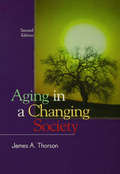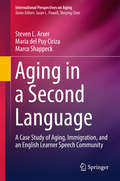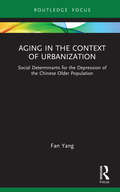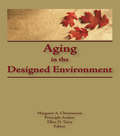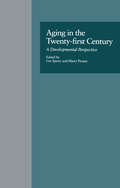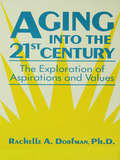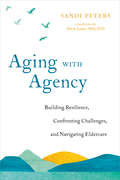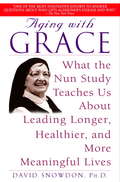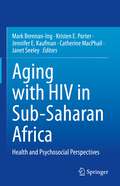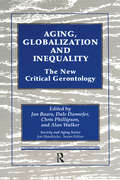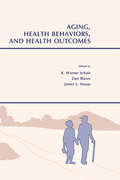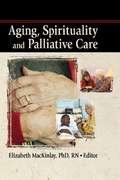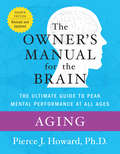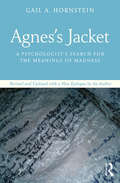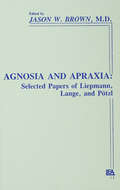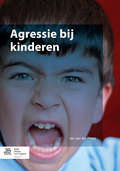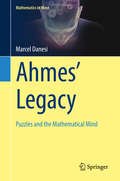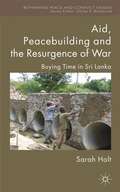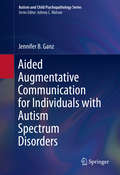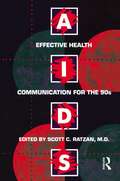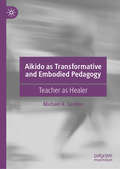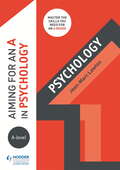- Table View
- List View
Aging in a Changing Society
by James ThorsonThe field of gerontology, the study of aging, has emerged as an area of increasing importance. This book is an introduction to the multidisciplinary field of gerontology. The text, with its friendly narrative style, assumes no prior knowledge of gerontology, sociology, or psychology.
Aging in a Second Language: A Case Study of Aging, Immigration, and an English Learner Speech Community (International Perspectives on Aging #17)
by Steven L. Arxer Maria del Puy Ciriza Marco ShappeckThis unique account of English language acquisition by Latino elders shines intimate light on the increasingly complex concerns of aging immigrant minority populations. Rich qualitative findings detail sociocultural barriers to and social and emotive factors that promote second language acquisition in older age. The book's case study highlights diverse cognitive and social processes as elders establish a sense of self as learners and as part of a learning community, and a sense of place as newcomers navigating a challenging environment. And first-person comments from the group members deftly illustrate the intricacies of being an immigrant in a rapidly changing America as well as the myriad intersections of race/ethnicity, gender, culture, and country that shape immigrant life. Included in the coverage: Minority aging in an immigrant context. Late-life second language acquisition: cognitive and psycholinguistic changes, challenges, and opportunities. Building emotions for self-identity and learning. Practicing safe language socialization in private and public spaces. Language resocialization and gender allies. Aging, second language acquisition, and health. Aging in a Second Language gives clinical social workers, gerontologists, health and cross-cultural psychologists, sociologists, educators and other professionals deep insights into the lives of an emerging active elder population. It also pinpoints challenges and opportunities in research, literacy program design, pedagogy, clinical outreach, education policy, and service delivery to immigrant elders.
Aging in the Context of Urbanization: Social Determinants for the Depression of the Chinese Older Population (China Perspectives)
by Fan YangAs China has undergone rapid urbanization and population aging in the past few decades, improving the welfare of older people in rural areas has become an ever more pressing issue. This title is the first book-length work to examine the influence of urbanization on the mental health of China’s older population outside the city. Incorporating the theoretical framework of social ecology, the author analyzes the socio-cultural factors that have exerted an impact on participants’ mental health, such as their personal life course transition, changes to family living arrangements and community restructuring. Moreover, he introduces several elderly mental health intervention models in China, while evaluating the policy initiatives that have developed based on China’s local resource sufficiency, cultural customs, and older people's needs. The research findings not only facilitate a deeper understanding of China's welfare policy making, but also offers a useful reference for countries that are experiencing similar urbanization and population aging and that wish to formulate better social policies. Students and scholars of social policy, welfare, and gerontology will find this title to be essential reading.
Aging in the Designed Environment
by Ellen D Taira Margaret ChristensonAging in the Designed Environment is the key sourcebook for physical and occupational therapists developing and implementing environmental designs for the aging. The physical environment remains one of the most overlooked areas in environmental design. In order to move beyond this status quo, persons responsible for planning elderly environments must develop a new understanding of ways in which their influence can improve the older adult’s physical and mental functioning. Occupational and physical therapists, as well as other health care professionals, will benefit tremendously from the information presented in this unique volume. Designers, developers, and others with minimal health care background will also find a wealth of possibilities within Aging in the Designed Environment. Many concerns are dealt with in the book’s five sections. The first section describes the implications that occur when there are changes in vision, hearing, taste, smell, touch, and the kinesthetic systems. Recommendations for environmental adaptation and modifications which may compensate for the changes in each of these systems are suggested. The second section stresses the relationship between behavior and environment. A variety of environmental attributes--comfort, privacy, accessibility, control, security, dignity--and their impacts are discussed, along with information on ways that attributes can be incorporated into the living settings of older people. In section three the focus is on the older person living independently in his or her own home, and section four covers exclusively the design and selection of chairs for older adults. New ways to assess and evaluate the home to promote independence beyond the traditional activities of daily living are addressed. The last section deals with redesigning the existing long-term care facility. The author examines some of the environmental conditions existing in specific facilities and provides recommendations to compensate for these circumstances.
Aging in the Twenty-first Century: A Developmental Perspective (Issues in Aging)
by Len Sperry Harry ProsenCovering a wide range of topics, this collection of original essays deals with the consequences and challenges of our growing aging population on society. It emphasizes aging as a developmental process while addressing the future of the practice of geropsychiatry and geriatric psychotherapy. This book serves as a valuable resource to guide clinical training, practice, and research on aging into the next century and beyond.
Aging into the 21st Century: The Exploration of Aspirations and Values
by Rachelle A. DorfmanAging Into the 21st Century draws on developmental theory and gerontological research to provide a framework for the creation of 'value-friendly' long-term care settings and for psychotherapy with the elderly.
Aging with Agency: Building Resilience, Confronting Challenges, and Navigating Eldercare
by Sandi PetersAn experiential guide to re-orienting our understanding of late adulthood as one of life's most meaningful and transformative stagesAging can bring new fears, challenges, and concerns. Loss of career, loved ones, or changing physical and cognitive abilities can leave us feeling isolated and scared. Sandi Peters shows us that growing older need not mean the end of personal growth. In fact, late adulthood can prove to be the most meaningful and transformative period of one's life. The key, says Peters, is the development of one's inner life, and with it a shift in one's relation to the aging process. The book draws on history, philosophy, psychology, gerontology, and spirituality to deepen and expand our understanding of what it means to grow old in the twenty-first century. Peters shares time-tested contemplative practices such as meditation, active imagination, dream work, and creative writing designed to enhance one's inner worlds and enable us to face life's inevitable changes with equanimity and insight. She offers practical advice on issues such as assisted living and home care, and a refreshingly new perspective on matters of memory and cognitive change.
Aging with Grace - What the Nun Study Teaches Us About Leading Longer, Healthier, and More Meaningful Lives: What the Nun Study Teaches Us About Leading Longer, Healthier, and More Meaningful Lives
by David SnowdonIn 1986 Dr. David Snowdon, one of the world’s leading experts on Alzheimer’s disease, embarked on a revolutionary scientific study that would forever change the way we view aging—and ultimately living. Dubbed the “Nun Study” because it involves a unique population of 678 Catholic sisters, this remarkable long-term research project has made headlines worldwide with its provocative discoveries. Yet Aging with Grace is more than a groundbreaking health and science book. It is the inspiring human story of these remarkable women—ranging in age from 74 to 106—whose dedication to serving others may help all of us live longer and healthier lives. Totally accessible, with fascinating portraits of the nuns and the scientists who study them, Aging with Grace also offers a wealth of practical findings: • Why building linguistic ability in childhood may protect against Alzheimer’s • Which ordinary foods promote longevity and healthy brain function • Why preventing strokes and depression is key to avoiding Alzheimer’s • What role heredity plays, and why it’s never too late to start an exercise program • How attitude, faith, and community can add years to our lives A prescription for hope, Aging with Grace shows that old age doesn’t have to mean an inevitable slide into illness and disability; rather it can be a time of promise and productivity, intellectual and spiritual vigor—a time of true grace.
Aging with HIV in Sub-Saharan Africa: Health and Psychosocial Perspectives
by Catherine MacPhail Janet Seeley Mark Brennan-Ing Kristen E. Porter Jennifer E. KaufmanWith the development of effective antiretroviral therapies (ART) in the mid-1990s, HIV became a treatable although serious condition, and people who are adherent to HIV medications can attain normal or near-normal life expectancies. Because of the success of ART, people 50 and older now make up a majority of people with HIV in high-income countries and other places where ART is accessible. The aging of the HIV epidemic is a global trend that is also being observed in low- and middle-income countries, including countries in sub-Saharan Africa, where the greatest number of older people with HIV reside (3.7 million). While globally over half of older adults with HIV are in sub-Saharan Africa, we have little information about the circumstances, needs, and resiliencies of this population, which limits our ability to craft effective policy and programmatic responses to aging with HIV in this region. At present, our understanding of HIV and aging is dominated by information from the U.S. and Western Europe, where the epidemiology of HIV and the infrastructure to provide social care are markedly different than in sub-Saharan Africa. Aging with HIV in Sub-Saharan Africa addresses this gap in our knowledge by providing current research and perspectives on a range of health and psychosocial topics concerning these older adults from across this region. This volume provides a unique and timely overview of growing older with HIV in a sub-Saharan African context, covering such topics as epidemiology, health and functioning, and social support, as well as policy and program implications to support those growing older with HIV. There are very few published volumes that address HIV and aging, and this is the first book to consider HIV and aging in sub-Saharan Africa. Most publications in this area focus on HIV and aging in Uganda and South Africa. This volume broadens the scope with contributions from authors working in West Africa, Botswana, and Kenya. The range of topics covered here will be useful to professionals in a range of disciplines including psychology, epidemiology, gerontology, sociology, health care, public health, and social work.
Aging, Globalization and Inequality: The New Critical Gerontology (Society and Aging Series)
by Jan Baars, Dale Dannefer Chris Phillipson, and Alan WalkerThis book is a major reassessment of work in the field of critical gerontology, providing a comprehensive survey of issues by a team of contributors drawn from Europe and North America. The book focuses on the variety of ways in which age and ageing are socially constructed, and the extent to which growing old is being transformed through processes associated with globalisation. The collection offers a range of alternative views and visions about the nature of social ageing, making a major contribution to theory-building within the discipline of gerontology. The different sections of the book give an overview of the key issues and concerns underlying the development of critical gerontology. These include: first, the impact of globalisation and of multinational organizations and agencies on the lives of older people; second, the factors contributing to the "social construction" of later life; and third, issues associated with diversity and inequality in old age, arising through the effects of cumulative advantage and disadvantage over the life course. These different themes are analysed using a variety of theoretical perspectives drawn from sociology, social policy, political science, and social anthropology. "Aging, Globalization and Inequality" brings together key contributors to critical perspectives on aging and is unique in the range of themes and concerns covered in a single volume. The study moves forward an important area of debate in studies of aging, and thus provides the basis for a new type of critical gerontology relevant to the twenty-first century.
Aging, Health Behaviors, and Health Outcomes (Social Structure and Aging Series)
by K. Warner Schaie Dan Blazer James S. HouseThis volume is the fourth in a series designed to facilitate inter-disciplinary communication between scientists concerned with the description of societal phenomena and those investigating adult development. As such, it contains a compilation of papers presented at an annual conference held at the Pennsylvania State University. These essays by sociologists and epidemiologists deal with the impact of disease and health outcomes with advancing age and are critiqued by members of related disciplines. In addition, there are overviews as well as specific discussions about the impact of cancer, depression, and cardiovascular diseases upon psychosocial functions.
Aging, Representation, and Thought: Gestalt and Feature-Intensive Processing
by Matthew SharpsThe brain contains many distinct functional and anatomical regions. Despite these differences, brain tissues are sufficiently uniform in the fact that they can engage in various types of processing. How can functionally different kinds of processes, such as verbal memory and reasoning, visual and auditory memory, and mental imagery, all be supported by the relatively uniform electrochemical activity of a brain's neurons? How are they appropriately segregated and integrated as needed? In Aging, Representation, and Thought, Matthew J. Sharps provides an empirically based, functional answer to what is, from the standpoint of modern cognitive psychology, a critical theoretical issue.Sharps argues that the crucial factor is the degree to which information is subjected to processing that is more gestalt or feature-intensive in nature. Sharps shows that purely gestalt processing deals with information in large "chunks," providing for relatively little incisive analysis. Purely feature-intensive processing, on the other hand, tends to ignore the overall nature and context of information in favor of comparatively minute analyses. It provides for relatively comprehensive analysis, but also for slow, cumbersome processing. Neither process, however, works in isolation, and Sharps demonstrates how information processing occurs on a continuum between the two extremes.Sharps' theoretical perspective is amply borne out by the results of specific experiments in all of the cognitive realms he addresses. He provides relatively comprehensive explanations for a variety of phenomena including the diminution of specific cognitive processes with age, and errors in eyewitness memory, reasoning, and decision-making at all levels of human activity. Aging, Representation, and Thought will be of interest to psychologists, students of adult development and aging, and management specialists.
Aging, Spirituality and Palliative Care
by Rev Elizabeth MackinleyGain greater depth of understanding of end-of-life spiritual issues for older adultsThe period of time when a person approaches death is always difficult both for the patient and the caregiver. Aging, Spirituality, and Palliative Care discusses best practices in aged and palliative care while addressing patients&’ diverse spiritual
Aging: The Owner's Manual
by Pierce HowardCutting-edge, user-friendly, and comprehensive: the revolutionary guide to the brain, now fully revised and updatedAt birth each of us is given the most powerful and complex tool of all time: the human brain. And yet, as we well know, it doesn't come with an owner's manual--until now. In this unsurpassed resource, Dr. Pierce J. Howard and his team distill the very latest research and clearly explain the practical, real-world applications to our daily lives. Drawing from the frontiers of psychology, neurobiology, and cognitive science, yet organized and written for maximum usability, The Owner's Manual for the Brain, Fourth Edition, is your comprehensive guide to optimum mental performance and well-being. It should be on every thinking person's bookshelf. What are the ingredients of happiness? Which are the best remedies for headaches and migraines? How can we master creativity, focus, decision making, and willpower? What are the best brain foods? How is it possible to boost memory and intelligence? What is the secret to getting a good night's sleep? How can you positively manage depression, anxiety, addiction, and other disorders? What is the impact of nutrition, stress, and exercise on the brain? Is personality hard-wired or fluid? What are the best strategies when recovering from trauma and loss? How do moods and emotions interact? What is the ideal learning environment for children? How do love, humor, music, friendship, and nature contribute to well-being? Are there ways of reducing negative traits such as aggression, short-temperedness, or irritability? What is the recommended treatment for concussions? Can you delay or prevent Alzheimer's and dementia? What are the most important ingredients to a successful marriage and family? What do the world's most effective managers know about leadership, motivation, and persuasion? Plus 1,000s more topics!
Agnes's Jacket: A Psychologist's Search for the Meanings of Madness.Revised and Updated with a New Epilogue by the Author
by Gail A. HornsteinIn a Victorian-era German asylum, seamstress Agnes Richter painstakingly stitched a mysterious autobiographical text into every inch of the jacket she created from her institutional uniform. Despite every attempt to silence them, hundreds of other psychiatric patients have managed to get their stories out, or to publish them on their own. Today, in a vibrant network of peer-advocacy groups all over the world, those with firsthand experience of emotional distress are working together to unravel the mysteries of madness and to help one another recover. Agnes’s Jacket tells their story, focusing especially on the Hearing Voices Network (HVN), an international collaboration of professionals, people with lived experience, and their families and friends who have been working to develop an alternative approach to coping with voices, visions, and other extreme states that is empowering and useful and does not start from the assumption that such people have a chronic illness. A vast gulf exists between the way medicine explains psychiatric conditions and the experiences of those who suffer. Hornstein’s work helps us to bridge that gulf, guiding us through the inner lives of those diagnosed with schizophrenia, bipolar illness, depression, and paranoia, and emerging with nothing less than a new model for understanding one another and ourselves.
Agnosia and Apraxia: Selected Papers of Liepmann, Lange, and Potzl (Institute for Research in Behavioral Neuroscience Series)
by Ellen Perecman Jason W. Brown George Dean Emil Franzen Joachim LuwischFirst Published in 1988. The reader is invited to explore this collection of early German papers and not to analyze the work through a comparison with the present but to approach it with a relaxation of bias that extends a new hearing to old ideas. The reader may be surprised to see how little has changed in the association or callosal theory of apraxia since this review by Liepmann. Of interest is the care with which Liepmann studied his patients and the ingenious anatomical accounts.
Agorafabulous!: Dispatches from My Bedroom
by Sara Benincasa“Sara Benincasa is one of the funniest writers I know—and I know a disturbing number of them. She is also one of the most honest.”—Sam Apple, author of American Parent and editor-in-chief of The Faster Times “Sara is extremely funny and should have many books out so we can all read them and laugh.” —Margaret ChoComedian, writer, blogger, radio and podcast host, and YouTube sensation, Sara Benincasa bravely and outrageously brings us “Dispatches from My Bedroom” with Agorafabulous! One of the funniest and most poignant books ever written about a mental illness, Agorafabulous! is a hilarious, raw, and unforgettable account of how a terrified young woman, literally trapped by her own imagination, evolved into a (relatively) high-functioning professional smartass. Down to earth and seriously funny, Benincasa’s no-holds-barred revelations offer readers the politically incorrect hilarity they heartily crave, yet is so often missing from your typical, weepy, and redemptive personal memoir.
Agressie bij kinderen
by Jan PloegAgressie is een probleem waarmee ouders, leerkrachten en hulpverleners dikwijls geen raad weten. Agressieve kinderen en jongeren blijken moeilijk te behandelen. Hoe moet agressie worden aangepakt? Waar komt agressie vandaag? Waarom is het ene kind wel en het andere niet agressief? En blijven agressieve kinderen altijd agressief? Op deze en andere vragen geeft dit boek antwoord. Agressie kan het functioneren van kinderen ernstig belemmeren. Thuis, op school en onder vrienden kan dat tot heftige problemen leiden. Voor opvoeders en hulpverleners is het van groot belang een goed inzicht te krijgen in het verschijnsel agressie. Dat kan helpen agressie een half toe te roepen of te voorkomen dat het agressieve kind steeds agressiever wordt. In de verschillende hoofdstukken belicht de auteur het verschijnsel agressie van begin tot eind. Het boek maakt duidelijk hoe agressie ontstaat, welke ontwikkelingen agressieve kinderen kunnen doormaken en welke oplossingen er zijn om agressie te voorkomen of in te perken. Dit helder geschreven overzichtswerk is bedoeld voor (aankomend) orthopedagogen, psychologen, sociaal-pedagogische hulpverleners, leerkrachten, beleidsmakers en andere professionals die met agressieve jeugdigen te maken hebben of krijgen.
Ahmes’ Legacy: Puzzles And The Mathematical Mind (Mathematics in Mind)
by Marcel DanesiThis book looks at classic puzzles from the perspective of their structures and what they tell us about the brain. It uses the work on the neuroscience of mathematics from Dehaene, Butterworth, Lakoff, Núñez, and many others as a lens to understand the ways in which puzzles reflect imaginative processes blended with rational ones. The book is not about recreational or puzzle-based mathematics in and of itself but rather about what the classic puzzles tell us about the mathematical imagination and its impact on the discipline. It delves into the history of classic math puzzles, deconstructing their raison d’être and describing their psychological features, so that their nature can be fleshed out in order to help understand the mathematical mind.This volume is the first monographic treatment of the psychological nature of puzzles in mathematics. With its user-friendly technical level of discussion, it is of interest to both general readers and those who engage in the disciplines of mathematics, psychology, neuroscience, and/or anthropology. It is also ideal as a textbook source for courses in recreational mathematics, or as reference material in introductory college math courses.
Aid, Peacebuilding and the Resurgence of War
by Sarah HoltAs one of South Asia's oldest democracies Sri Lanka is a critical case to examine the limits of a liberal peace, peacebuilding and external engagement in the settlement of civil wars. Based on nine years of research, and more than 100 interviews with those affected by the war, NGOs, and local and international elites engaged in the peace process.
Aided Augmentative Communication for Individuals with Autism Spectrum Disorders (Autism and Child Psychopathology Series)
by Jennifer B. GanzJust as autism is a continuum of disorders, it is associated with a broad range of neurodevelopmental, social, and communication deficits. For individuals with autism spectrum disorders (ASD), augmentative and alternative communication (AAC) has a major impact on their daily lives, often reducing the occurrence of challenging behaviors. Aided Augmentative Communication for Individuals with Autism Spectrum Disorders is a practical guide to the field, offering readers a solid grounding in ASD, related complex communication needs (CCN), and AAC, especially visual and computer-based technologies. Widely used interventions and tools in AAC are reviewed--not just how they work, but why they work--to aid practitioners in choosing those most suited to individual clients or students. Issues in evaluation for aided AAC and debates concerning its usability round out the coverage. Readers come away with a deeper understanding of the centrality of communication for clients with ASD and the many possibilities for intervention Key areas of coverage include: AAC and assessment of people with ASD and CCN. Interdisciplinary issues and collaboration in assessment and treatment. AAC intervention mediated by natural communication partners. Functional communication training with AAC. The controversy surrounding facilitated communication. Sign language versus AAC. Aided Augmentative Communication for Individuals with Autism Spectrum Disorders is an essential resource for clinicians/practitioners, researchers, and graduate students in such fields as child and school psychology, speech pathology, language education, developmental psychology, behavior therapy, and educational technology.
Aids: Effective Health Communicaton for the 90's
by Scott C. RatzanDespite educational efforts, the majority of Americans are still under the misconception that they are not at risk from HIV/AIDS infection. In addition, the federal government only spends 2% of the total designated federal AIDS funding toward prevention. Thus, information in respect to AIDS and health communication in any comprehensive nature is almost nonexistent.; This book aims to rectify the situation by presenting detailed analysis and actions necessary to confront the AIDS pandemic on every level of the communication realm. Contributors are experienced researchers, educators, government officials, and physicians. They examine the issue from a number of standpoints, including: communication, adolescent medicine, public administration, psychology, journalism, audiology, speech and language pathology, neurological surgery, preventive medicine and public health.
Aikido as Transformative and Embodied Pedagogy: Teacher as Healer
by Michael A. GordonDrawing on the author’s lifelong practice in the non-competitive and defensive Japanese art of Aikido, this book examines education as self-cultivation, from a Japanese philosophy (e.g. Buddhist) perspective. Contemplative practices, such as secular mindfulness meditation, are being increasingly integrated into pedagogical settings to enhance social and emotional learning and well-being and to address stress-induced overwhelm due to increased pressures on the education system and its constituents. The chapters in this book explore the various ways, through the lens of this non-violent relational art of Aikido, that pedagogy is always something being practiced (on the level of psychological, somatic and emotional registers) and thus holding potential for transformation into being more relational, ecological-minded, and reflecting more ‘embodied attunement.’ Positioning education as a practice, one of self-discovery, the author argues that one can approach personal development as engaging in a spiritual process of integrating mind and body towards full presence of being and existence.
Aiming for an A in A-level Psychology
by Jean-Marc LawtonExam Board: AQA, Edexcel, OCR, WJEC EduqasLevel: A-levelSubject: PsychologyFirst teaching: September 2015First exams: Summer 2017Master the skills you need to set yourself apart and hit the highest grades; this year-round course companion develops the higher-order thinking skills that top-achieving students possess, providing step-by-step guidance, examples and tips for getting an A grade.Written by experienced author and teacher Jean-Marc Lawton, Aiming for an A in A-level Psychology:- Helps you develop the 'A grade skills' of analysis, evaluation, creation and application- Takes you step by step through specific skills you need to master in A-level Psychology, so you can apply these skills and approach each exam question as an A/A* candidate- Clearly shows how to move up the grades with sample responses annotated to highlight the key features of A/A* answers- Helps you practise to achieve the levels expected of top-performing students, using in-class or homework activities and further reading tasks that stretch towards university-level study- Perfects exam technique through practical tips and examples of common pitfalls to avoid - Cultivates effective revision habits for success, with tips and strategies for producing and using revision resources- Supports all exam boards, outlining the Assessment Objectives for reaching the higher levels under the AQA, Edexcel, OCR, and WJEC/Eduqas specifications
Aiming for an A in A-level Psychology
by Jean-Marc LawtonExam Board: AQA, Edexcel, OCR, WJEC Eduqas Level: A-level Subject: Psychology First teaching: September 2015 First exams: Summer 2017Master the skills you need to set yourself apart and hit the highest grades; this year-round course companion develops the higher-order thinking skills that top-achieving students possess, providing step-by-step guidance, examples and tips for getting an A grade.Written by experienced author and teacher Jean-Marc Lawton, Aiming for an A in A-level Psychology:- Helps you develop the 'A grade skills' of analysis, evaluation, creation and application- Takes you step by step through specific skills you need to master in A-level Psychology, so you can apply these skills and approach each exam question as an A/A* candidate- Clearly shows how to move up the grades with sample responses annotated to highlight the key features of A/A* answers- Helps you practise to achieve the levels expected of top-performing students, using in-class or homework activities and further reading tasks that stretch towards university-level study- Perfects exam technique through practical tips and examples of common pitfalls to avoid - Cultivates effective revision habits for success, with tips and strategies for producing and using revision resources- Supports all exam boards, outlining the Assessment Objectives for reaching the higher levels under the AQA, Edexcel, OCR, and WJEC/Eduqas specifications
